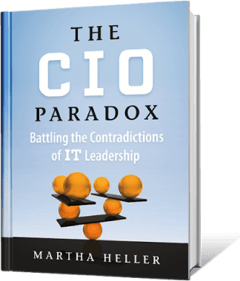The CIO position is unique, bringing together a broad and often contradictory set of responsibilities that are essential to a company's operations, growth, and increasingly, its very survival. Read on to learn more about this critical executive.
Along came Y2K, followed by the dot-com era, mobility, and other fast-moving major developments, all of which moved IT to the center of the conversation in business.
When the role emerged in 1980s, an elevation of the "M.I.S. Director" position common at the time, the CIO was in charge of managing and maintaining the company's information technologies - its mainframe computers, file and print servers, application servers, networking hardware, personal computers, and software used to create, store, process and exchange information, as well as the department staff, vendors and budget. These CIOs usually reported to the CFO.
In the 1990s, ERP and other enterprise software packages hit the scene, so IT and the CIO became more visible to some, but still irrelevant to the vast majority of a company's employees and customers. Then along came Y2K, followed by the dot-com era, mobility, and other fast-moving major developments, all of which moved information technology to the center of the conversation in business.
All of the company’s employees and all of its customers are using technology that the CIO is ultimately responsible for, all of the time.
Digital technologies around the use of data, predictive analytics, cybersecurity, internet of things (IoT), artificial intelligence (AI), robotic process automation (RPA), block chain, voice interface, and many more, have changed the very fundamentals of commerce. As these digital technologies and others that continually arrive on the scene transform virtually all businesses, the role and responsibilities of the CIO continue to evolve and expand rapidly.
Now, technology belongs to everyone. All of the company’s employees and all of its customers are using technology that the CIO is ultimately responsible for, all of the time. Technology is at the heart of every business.
Today’s top performing CIOs are digital and transformational leaders as well as business strategists. While there has been a “C” in the job title for decades, they weren’t considered true equals in the C-suite until quite recently. Now, most CIOs are members of the executive leadership team and the CEO’s brain trust. They are expected to attend board meetings and educate board members about the business opportunities and risks that new technologies offer, while keeping the technobabble and IT jargon to a minimum.
Be the Business: CIOs in the New Era of IT, by Martha Heller
CIOs in the vanguard of the profession are restructuring IT around services and products, as opposed to software applications and projects. They are creating an “IT investment management culture” among all their business partners. They are meeting with external customers and developing strong relationships with their business partners. They are fostering cultures of accountability and transparency and building high performing teams.
While our recruiters develop a list of specialized attributes on every CIO search project, tailored to the client's industry, technology stack, business strategy, competitive challenges, etc., we are always in pursuit of a set of universal skills we believe all CIOs should possess, based on our experience, in order to maximize their success in the role.
Consider the fact that digital technologies were already changing customer behavior and disrupting businesses far faster than a company’s ability to change culture, processes, and behaviors. Then, along comes COVID-19, accelerating these disruptions!
Technology implementation experience and skills are still important, but the kind of transformation abilities we look for in our clients' future CIOs result in strategic changes to the IT operating model, and the company’s culture: creating end-to-end processes out of legacy silos, establishing a data-driven mindset across a business unit or the enterprise, and putting the customer at the center of business operations.
What Is the CIO’s Role Today? Redefining transformational IT leadership
When we ask a CIO candidate an open-ended question like, “What was happening at your current company when you joined?” and he responds with horror stories about software outages and legacy technologies, we cannot check the box next to business acumen just yet. But when a candidate’s answer goes into shifts in customer behavior, slowing sales, or new product lines, that is a strong sign of business acumen. We will certainly probe into how the candidate improved the technology environment, but to gauge business acumen we are listening for responses that are close to how a CEO would answer the same question.
In a world where software and data are more central to your business operations than ever, building a solid team is not enough. What we (and our clients) are after when we say “team development” is cultural change. Has this person shifted IT from a project management to a product management culture? Has she focused her team on business outcomes rather than delivery deadlines?
How IT Leaders Are Solving Their Talent Challenges
When we interview a candidate for a CIO role we are recruiting, we ask a series questions designed to help determine how strategically they think and approach their work. We often hear interesting stories and ideas about new business models, revenue generation, improved performance and cost reduction. Such ideas are music to our ears, and form a great start, but they’re just half the story. Equally important is how the candidate articulated the vision, the desired business outcomes, and all of the operational changes that had to happen to get from the status quo to the desired end state. How, specifically, did they communicate and build consensus and support? There are lots of great strategies floating around at most companies. The real work is getting an idea from someone’s brain and taking it all the way into production.
Does your company need a CIO, a CTO, or both?
When Heller Search is recruiting a CIO to replace one who was (or is about to be) fired, our clients typically tell us about disastrous IT projects that went way over budget, or are currently “on fire.” So, we will usually ask interviewees, “Can you describe a failing project that you successfully turned around?”
Most experienced IT leaders have a great answer, whether it was landing an SAP implementation plane that has been in flight for three years, or resuscitating an e-commerce platform that went down just before the holidays. Again, that is price of entry. But once they put out the proverbial fire, we want to know whether they improved the project management capabilities of their team, and how? Did they change the way incentives were structured to ensure continual business benefit from completed projects? The real question is, “What changes did you make to ensure that failing projects become a thing of the past?”
8 Key Steps to Selecting New Software
Transparency does not mean having an open-door policy or inviting all of your business partners to your project update meetings. Transparency is a collaborative process whereby a CIO turns her user community from IT consumers into co-investors. It’s creating an investment management culture that drives more decisions to the part of the business where the return on those investments is actually realized.
Micromanager or Focused Leader? Recognizing the distinctions
A CIO may attend every marketing meeting. He could grab lunch with the CHRO each and every Tuesday. These are all very good signs of an IT leader who values strong relationships with their business partners. But what matters even more is what the partnership looks like one level below CIO. And a level below that. The strongest answers to questions a recruiter might ask a CIO candidate about business partnership describe an IT organizational re-design that balances enterprise services with leaders dedicated to business units or functions—Business Relationship Management –and a CIO who pre-sells the new structure to ensure the success of those new relationships, rather than rely on the org chart do all the work.
Download The Ultimate IT Business Relationship Manager Job Description
 At Heller Search, we love newsletters. In fact, we have produced a weekly e-newsletter, The Heller Report, for going on nine years! But a newsletter cannot carry the weight of a CIO’s communication goals. Rather, what frameworks has the CIO employed to educate the executive committee on the true cost of legacy technologies and the value of increased investment? How has she ensured a tight feedback loop from her business partners back to IT? How has she—in collaboration with colleagues—driven digital literacy throughout the company?
At Heller Search, we love newsletters. In fact, we have produced a weekly e-newsletter, The Heller Report, for going on nine years! But a newsletter cannot carry the weight of a CIO’s communication goals. Rather, what frameworks has the CIO employed to educate the executive committee on the true cost of legacy technologies and the value of increased investment? How has she ensured a tight feedback loop from her business partners back to IT? How has she—in collaboration with colleagues—driven digital literacy throughout the company?
The CIO Paradox: Battling the Contradictions of IT Leadership, by Martha Heller
How can four little letters define the future of our world? For such a short word, data is the new currency of our businesses. While we definitely want to know about the data lake and AI engine a candidate was responsible for, what our clients need is a leader who, yes, can implement the tools, but can also can work with his or her business partners to change behaviors to create a data-driven business.
How to Operationalize Data to Deliver Business Results
When our client is satisfied that our CIO candidate is an experienced and talented leader who builds teams, creates partnerships, and drives transformation, they will ask, “But is he technical?” What is technical depth to a CIO? For a small company with a small team, it might mean leading custom development and acting as project lead on a cloud migration; for a Fortune 500 company it might mean understanding the advantages of one architecture over another and knowing how to hire the right CTO. But it always means the ability to dive deep on technology when you need to and having an acute knowledge of the provider marketplace.
Rules of Business Technology Modernization
Our clients do not expect their CIOs to be technical experts in network security, but they do expect them to hire the right CISO, someone who can talk to the board about risk profile and security investments that will not cause a coronary event. The language of the board is the language of finance, so whether or not the CIO wears the CISO hat, as many do, we are interested in clear articulation of security investments.
26 Cybersecurity Acronyms and Terms IT Recruiters Should Know

In the old days (which were not that long ago), vendor management was all about contract negotiation, ensuring SLAs, and driving costs down. Those activities still matter a lot, but consider this: in the past year, we have had a number of clients tell us that their business model is evolving to the point where they can no longer rely on their traditional vendors for their technology roadmap. These companies need their CIOs to make smart bets on high tech start-ups and new vendors that provide niche solutions for the business they are becoming. Vendor management involves a venture capitalist’s eye on the emerging technology market.
9 Tips for Becoming a Great Tech Contract Negotiator